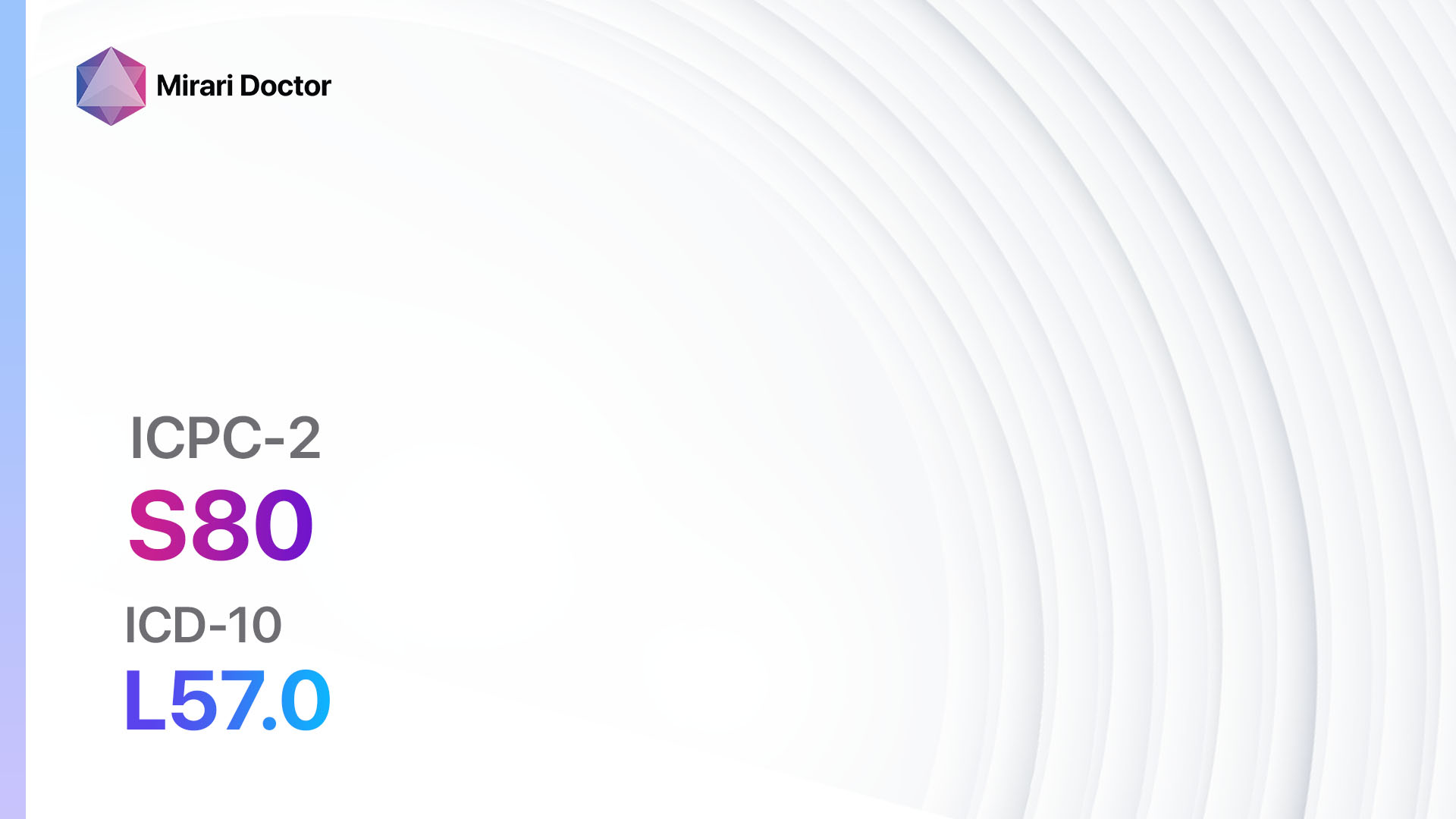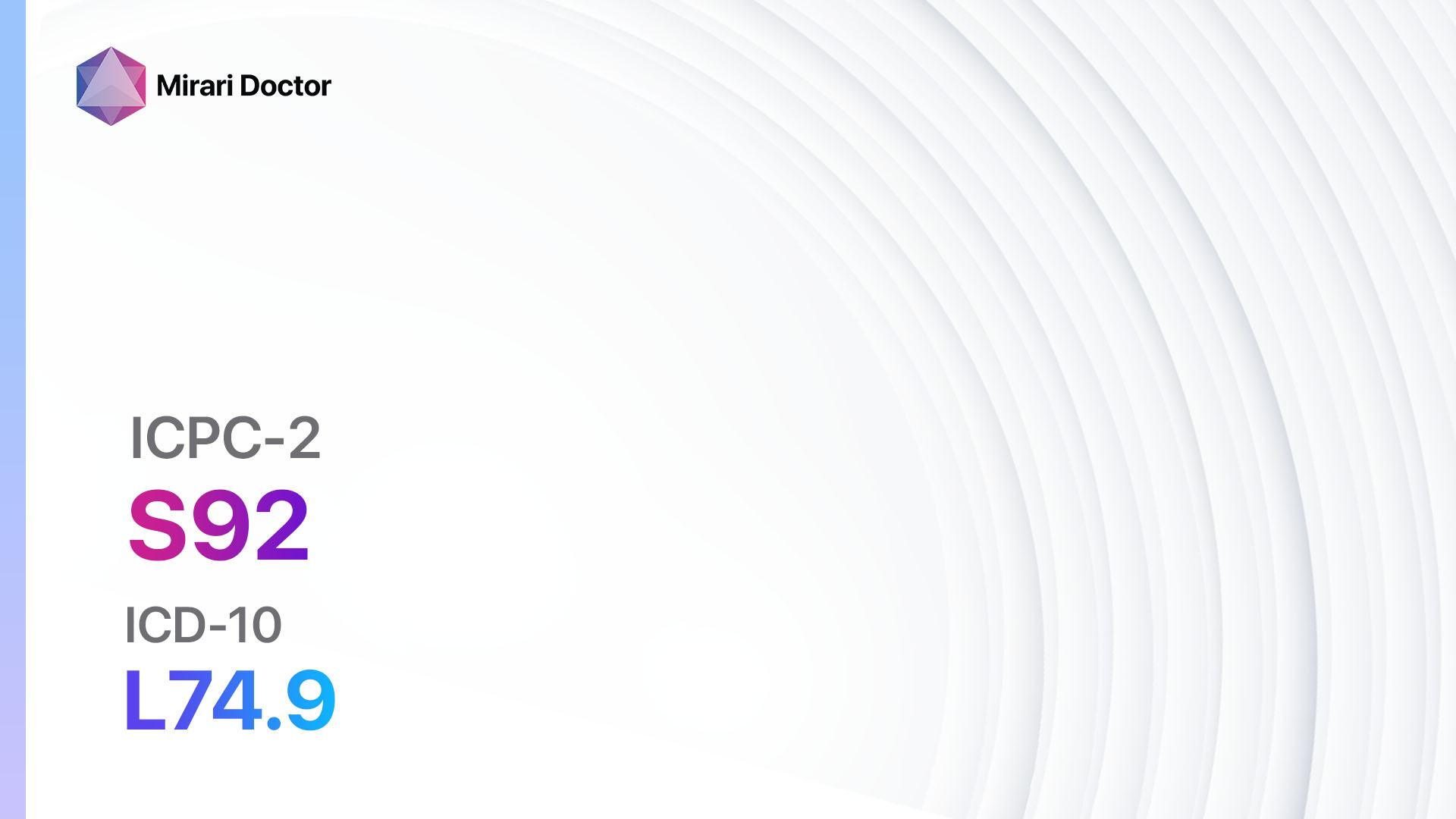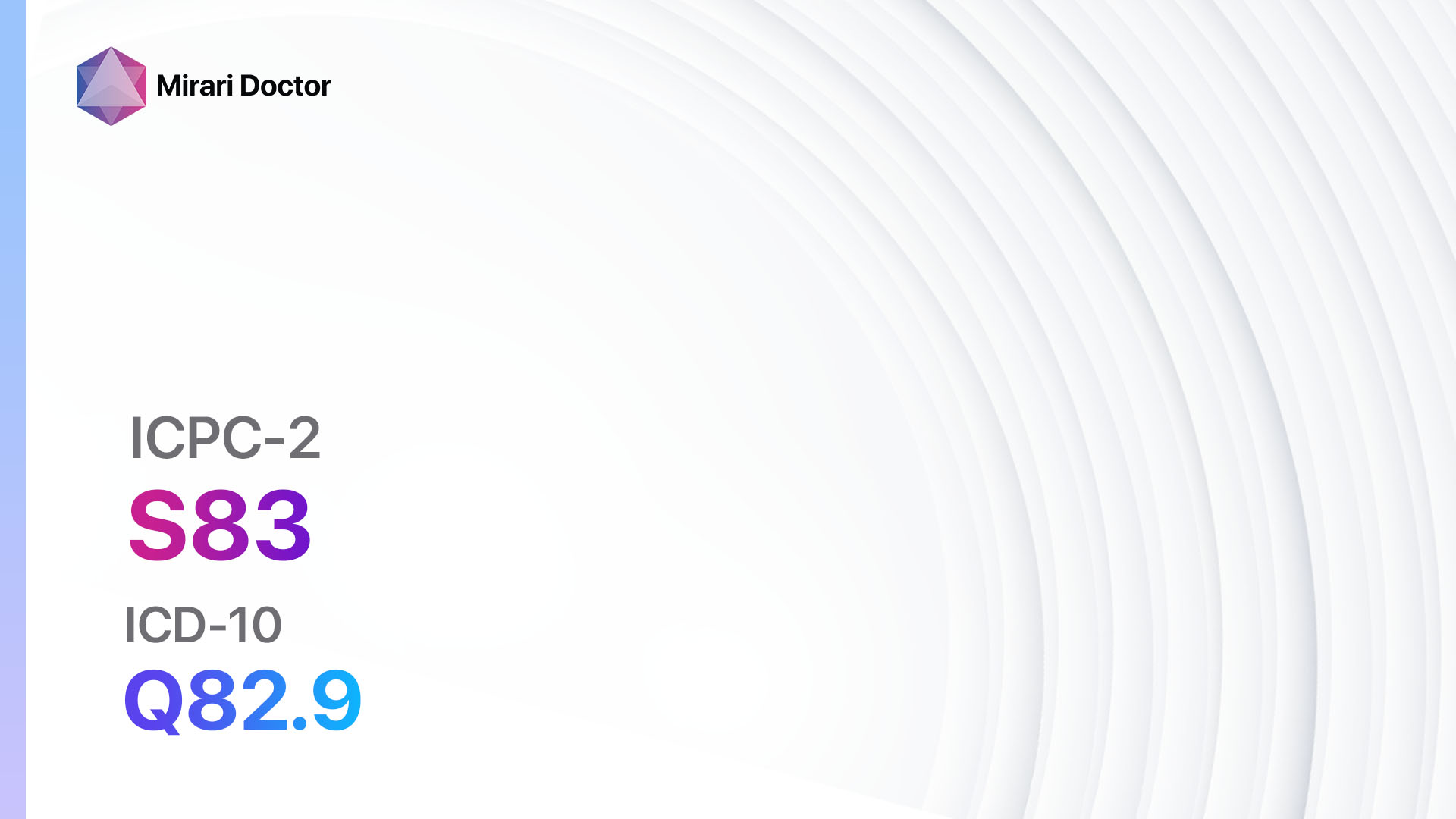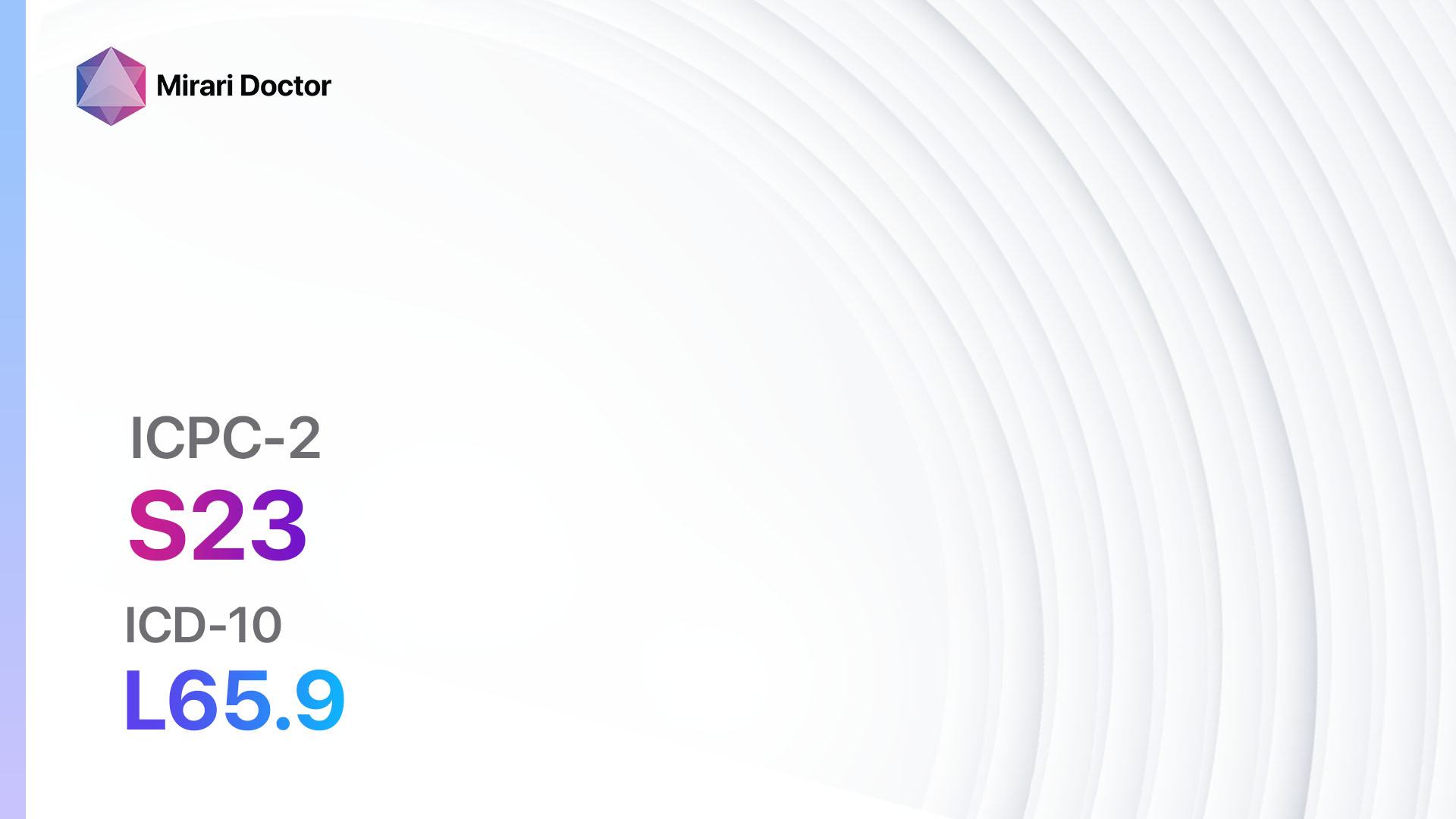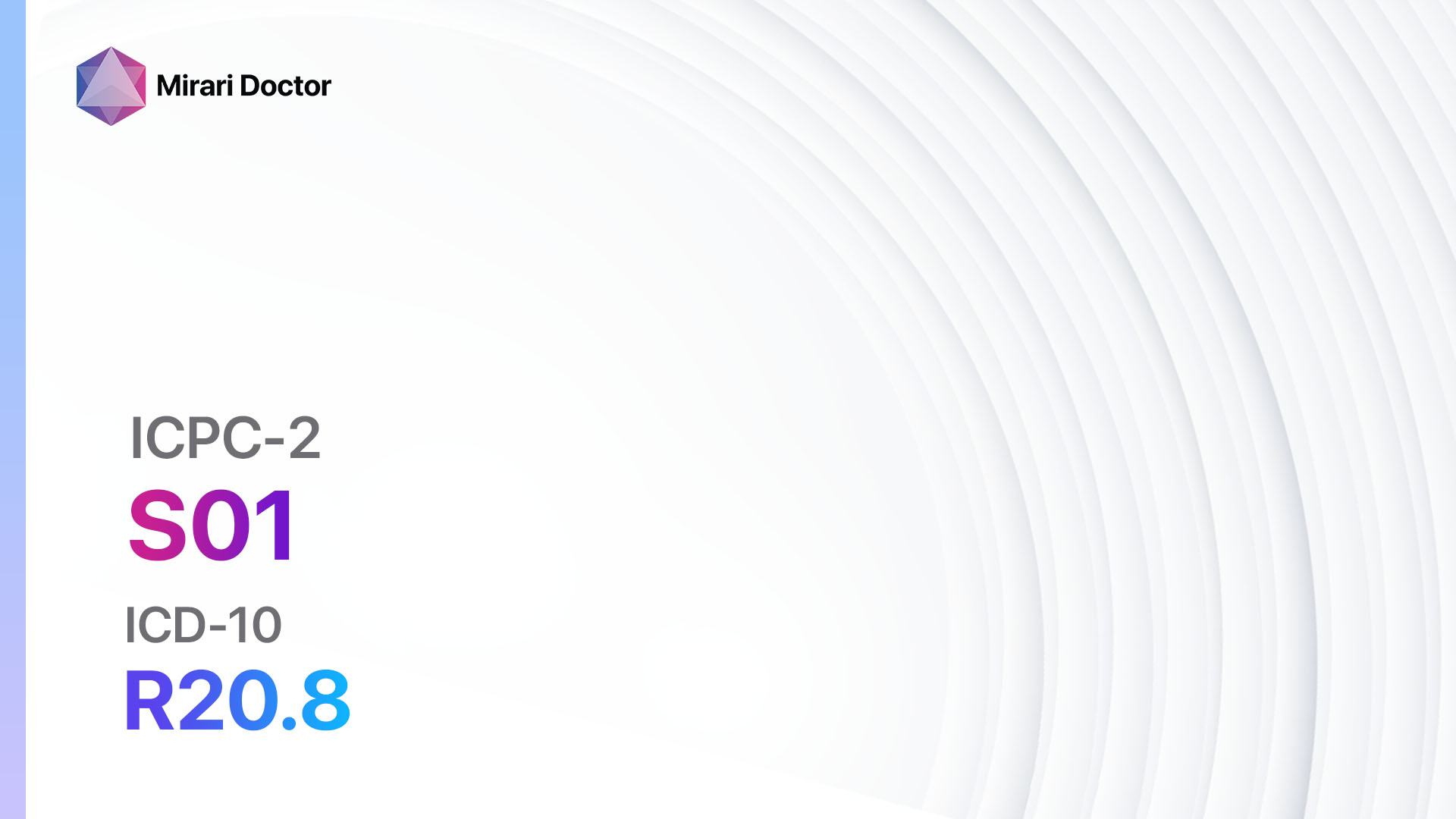
Introduction
Pain/tenderness of the skin refers to discomfort or sensitivity experienced in the skin. It can be caused by various factors, including injury, inflammation, infection, or nerve damage.[1] The aim of this guide is to provide an overview of the symptoms, causes, diagnostic steps, possible interventions, and lifestyle interventions for pain/tenderness of the skin.
Codes
- ICPC-2 Code: S01 Pain/tenderness of skin
- ICD-10 Code: R20.8 Other and unspecified disturbances of skin sensation[2]
Symptoms
- Pain: The primary symptom of pain/tenderness of the skin is the presence of localized or widespread pain in the affected area.
- Tenderness: The skin may feel tender to touch, and pressure applied to the area may exacerbate the pain.[3]
Causes
- Injury: Trauma or injury to the skin, such as cuts, burns, or bruises, can cause pain and tenderness.
- Inflammation: Inflammatory conditions, such as dermatitis or cellulitis, can lead to pain and tenderness of the skin.
- Infection: Skin infections, including bacterial, viral, or fungal infections, can cause pain and tenderness.
- Nerve damage: Damage to the nerves supplying the skin can result in pain and tenderness.[4]
Diagnostic Steps
Medical History
- Gather information about the patient’s medical history, including any previous skin conditions, injuries, or infections.
- Identify any risk factors that may contribute to the development of pain/tenderness of the skin, such as exposure to irritants or allergens.
- Assess the duration, severity, and location of the pain/tenderness.[5]
Physical Examination
- Perform a thorough physical examination of the affected area, noting any visible signs of injury, inflammation, or infection.
- Palpate the skin to assess for tenderness and evaluate the extent of pain.
- Check for any associated symptoms, such as redness, swelling, or warmth.[6]
Determine Severity
- Classify the pain/tenderness of the skin based on severity and depth, if applicable:
- Mild: Discomfort or tenderness that does not significantly impact daily activities.
- Moderate: Pain or tenderness that interferes with daily activities but can be managed with conservative measures.
- Severe: Intense pain or tenderness that significantly impairs daily functioning and requires medical intervention.[7]
Laboratory Tests
- Blood tests: Complete blood count (CBC) and inflammatory markers (e.g., C-reactive protein) may be performed to assess for infection or inflammation.
- Skin culture: A sample of the affected skin may be collected and sent for culture to identify the presence of any bacterial or fungal infection.
- Biopsy: In some cases, a skin biopsy may be necessary to evaluate the underlying cause of the pain/tenderness.[8]
Diagnostic Imaging
- X-rays: X-rays may be ordered to assess for any underlying fractures or bone abnormalities that may be contributing to the pain/tenderness.
- Ultrasound: Ultrasound imaging can help visualize soft tissues and identify any abnormalities, such as fluid collections or abscesses.
- MRI: Magnetic resonance imaging (MRI) may be used to evaluate deeper structures, such as muscles or nerves, for any signs of damage or inflammation.[9]
Follow-up and Patient Education
- Schedule follow-up appointments to monitor the progress of the condition and adjust treatment as necessary.
- Provide patient education regarding self-care measures, including wound care, pain management, and the importance of adherence to treatment[10].
Possible Interventions
Traditional Interventions
Medications:
Top 5 drugs for pain/tenderness of the skin:
- Nonsteroidal anti-inflammatory drugs (NSAIDs) (e.g., Ibuprofen, Naproxen):
- Cost: Generic versions can be $3-$20/month.
- Contraindications: History of gastrointestinal bleeding, renal impairment.
- Side effects: Upset stomach, heartburn, increased risk of bleeding.
- Severe side effects: Gastrointestinal ulcers, kidney damage, allergic reactions.
- Drug interactions: Blood thinners, corticosteroids.
- Warning: Prolonged use may increase the risk of cardiovascular events.
- Topical analgesics (e.g., Lidocaine, Capsaicin):
- Cost: Varies depending on the specific product.
- Contraindications: Allergy to local anesthetics or capsaicin.
- Side effects: Skin irritation, burning sensation.
- Severe side effects: Allergic reactions, skin rash.
- Drug interactions: None reported.
- Warning: Avoid contact with eyes or mucous membranes.
- Antibiotics (e.g., Amoxicillin, Cephalexin):
- Cost: Generic versions can be $5-$30/month.
- Contraindications: Allergy to penicillin or cephalosporins.
- Side effects: Upset stomach, diarrhea, rash.
- Severe side effects: Severe allergic reactions, Clostridium difficile infection.
- Drug interactions: Oral contraceptives, warfarin.
- Warning: Complete the full course of antibiotics as prescribed.
- Antifungal agents (e.g., Clotrimazole, Terbinafine):
- Cost: Generic versions can be $5-$30/month.
- Contraindications: Allergy to antifungal agents.
- Side effects: Skin irritation, rash.
- Severe side effects: Severe allergic reactions, liver damage.
- Drug interactions: None reported.
- Warning: Use as directed and continue treatment for the recommended duration.
- Antidepressants (e.g., Amitriptyline, Duloxetine):
- Cost: Generic versions can be $10-$50/month.
- Contraindications: Monoamine oxidase inhibitor (MAOI) use, recent myocardial infarction.
- Side effects: Dry mouth, drowsiness, constipation.
- Severe side effects: Serotonin syndrome, suicidal thoughts.
- Drug interactions: MAOIs, other antidepressants.
- Warning: May take several weeks to achieve therapeutic effect.
Alternative Drugs:
- Gabapentin: An anticonvulsant that can help relieve neuropathic pain.
- Tricyclic antidepressants: Amitriptyline, nortriptyline, and desipramine can be used for neuropathic pain.
- Corticosteroids: May be prescribed for inflammatory conditions causing pain/tenderness of the skin.
- Antiviral agents: Used for pain/tenderness of the skin caused by viral infections.
- Antihistamines: Can help alleviate itching and discomfort associated with allergic reactions.
Surgical Procedures:
- In some cases, surgical intervention may be necessary to address the underlying cause of pain/tenderness of the skin, such as removing an abscess or repairing nerve damage. The cost of surgical procedures can vary significantly depending on the specific procedure and location.
Alternative Interventions
- Acupuncture: May help alleviate pain and improve blood flow. Cost: $60-$120 per session.
- Chelation therapy: Controversial treatment involving the administration of chelating agents to remove heavy metals from the body. Cost: $75-$150 per session.
- Hyperbaric oxygen therapy: Involves breathing pure oxygen in a pressurized chamber to increase oxygen delivery to tissues. Cost: $200-$300 per session.
- Herbal supplements: Some herbs, such as arnica or calendula, may have potential benefits for reducing pain and inflammation. Cost: Varies depending on the specific supplement.
Lifestyle Interventions
- Rest and elevation: Elevating the affected area and avoiding excessive physical activity can help reduce pain and promote healing. Cost: None.
- Cold or warm compresses: Applying cold or warm compresses to the affected area can help alleviate pain and reduce inflammation. Cost: None.
- Proper wound care: Keeping the affected area clean and applying appropriate dressings can help prevent infection and promote healing. Cost: Varies depending on the specific wound care products.
- Stress management techniques: Stress can exacerbate pain, so practicing relaxation techniques, such as deep breathing or meditation, may help alleviate symptoms. Cost: None.
- Healthy lifestyle habits: Maintaining a balanced diet, regular exercise, and adequate sleep can contribute to overall well-being and potentially reduce pain. Cost: Varies depending on individual choices.
It is important to note that the cost ranges provided are approximate and may vary depending on the location and availability of the interventions.
Mirari Cold Plasma Alternative Intervention
Understanding Mirari Cold Plasma
- Safe and Non-Invasive Treatment: Mirari Cold Plasma is a safe and non-invasive treatment option for various skin conditions. It does not require incisions, minimizing the risk of scarring, bleeding, or tissue damage.
- Efficient Extraction of Foreign Bodies: Mirari Cold Plasma facilitates the removal of foreign bodies from the skin by degrading and dissociating organic matter, allowing easier access and extraction.
- Pain Reduction and Comfort: Mirari Cold Plasma has a local analgesic effect, providing pain relief during the treatment, making it more comfortable for the patient.
- Reduced Risk of Infection: Mirari Cold Plasma has antimicrobial properties, effectively killing bacteria and reducing the risk of infection.
- Accelerated Healing and Minimal Scarring: Mirari Cold Plasma stimulates wound healing and tissue regeneration, reducing healing time and minimizing the formation of scars.
Mirari Cold Plasma Prescription
Video instructions for using Mirari Cold Plasma Device – S01 Pain/tenderness of skin (ICD-10:R20.8)
| Mild | Moderate | Severe |
| Mode setting: 1 (Infection) Location: 0 (Localized) Morning: 15 minutes, Evening: 15 minutes |
Mode setting: 1 (Infection) Location: 0 (Localized) Morning: 30 minutes, Lunch: 30 minutes, Evening: 30 minutes |
Mode setting: 1 (Infection) Location: 0 (Localized) Morning: 30 minutes, Lunch: 30 minutes, Evening: 30 minutes |
| Mode setting: 2 (Wound Healing) Location: 0 (Localized) Morning: 15 minutes, Evening: 15 minutes |
Mode setting: 2 (Wound Healing) Location: 0 (Localized) Morning: 30 minutes, Lunch: 30 minutes, Evening: 30 minutes |
Mode setting: 2 (Wound Healing) Location: 0 (Localized) Morning: 30 minutes, Lunch: 30 minutes, Evening: 30 minutes |
| Mode setting: 7 (Immunotherapy) Location: 7 (Neuro system & ENT) Morning: 15 minutes, Evening: 15 minutes |
Mode setting: 7 (Immunotherapy) Location: 7 (Neuro system & ENT) Morning: 30 minutes, Lunch: 30 minutes, Evening: 30 minutes |
Mode setting: 7 (Immunotherapy) Location: 7 (Neuro system & ENT) Morning: 30 minutes, Lunch: 30 minutes, Evening: 30 minutes |
| Total Morning: 45 minutes approx. $7.50 USD, Evening: 45 minutes approx. $7.50 USD |
Total Morning: 90 minutes approx. $15 USD, Lunch: 90 minutes approx. $15 USD, Evening: 90 minutes approx. $15 USD, |
Total Morning: 90 minutes approx. $15 USD, Lunch: 90 minutes approx. $15 USD, Evening: 90 minutes approx. $15 USD, |
| Usual treatment for 7-60 days approx. $105 USD – $900 USD | Usual treatment for 6-8 weeks approx. $1,890 USD – $2,520 USD |
Usual treatment for 3-6 months approx. $4,050 USD – $8,100 USD
|
 |
|
Use the Mirari Cold Plasma device to treat Pain/tenderness of skin effectively.
WARNING: MIRARI COLD PLASMA IS DESIGNED FOR THE HUMAN BODY WITHOUT ANY ARTIFICIAL OR THIRD PARTY PRODUCTS. USE OF OTHER PRODUCTS IN COMBINATION WITH MIRARI COLD PLASMA MAY CAUSE UNPREDICTABLE EFFECTS, HARM OR INJURY. PLEASE CONSULT A MEDICAL PROFESSIONAL BEFORE COMBINING ANY OTHER PRODUCTS WITH USE OF MIRARI.
Step 1: Cleanse the Skin
- Start by cleaning the affected area of the skin with a gentle cleanser or mild soap and water. Gently pat the area dry with a clean towel.
Step 2: Prepare the Mirari Cold Plasma device
- Ensure that the Mirari Cold Plasma device is fully charged or has fresh batteries as per the manufacturer’s instructions. Make sure the device is clean and in good working condition.
- Switch on the Mirari device using the power button or by following the specific instructions provided with the device.
- Some Mirari devices may have adjustable settings for intensity or treatment duration. Follow the manufacturer’s instructions to select the appropriate settings based on your needs and the recommended guidelines.
Step 3: Apply the Device
- Place the Mirari device in direct contact with the affected area of the skin. Gently glide or hold the device over the skin surface, ensuring even coverage of the area experiencing.
- Slowly move the Mirari device in a circular motion or follow a specific pattern as indicated in the user manual. This helps ensure thorough treatment coverage.
Step 4: Monitor and Assess:
- Keep track of your progress and evaluate the effectiveness of the Mirari device in managing your Pain/tenderness of skin. If you have any concerns or notice any adverse reactions, consult with your health care professional.
Note
This guide is for informational purposes only and should not replace the advice of a medical professional. Always consult with your healthcare provider or a qualified medical professional for personal advice, diagnosis, or treatment. Do not solely rely on the information presented here for decisions about your health. Use of this information is at your own risk. The authors of this guide, nor any associated entities or platforms, are not responsible for any potential adverse effects or outcomes based on the content.
Mirari Cold Plasma System Disclaimer
- Purpose: The Mirari Cold Plasma System is a Class 2 medical device designed for use by trained healthcare professionals. It is registered for use in Thailand and Vietnam. It is not intended for use outside of these locations.
- Informational Use: The content and information provided with the device are for educational and informational purposes only. They are not a substitute for professional medical advice or care.
- Variable Outcomes: While the device is approved for specific uses, individual outcomes can differ. We do not assert or guarantee specific medical outcomes.
- Consultation: Prior to utilizing the device or making decisions based on its content, it is essential to consult with a Certified Mirari Tele-Therapist and your medical healthcare provider regarding specific protocols.
- Liability: By using this device, users are acknowledging and accepting all potential risks. Neither the manufacturer nor the distributor will be held accountable for any adverse reactions, injuries, or damages stemming from its use.
- Geographical Availability: This device has received approval for designated purposes by the Thai and Vietnam FDA. As of now, outside of Thailand and Vietnam, the Mirari Cold Plasma System is not available for purchase or use.
References
- Treede RD, Jensen TS, Campbell JN, et al. Neuropathic pain: redefinition and a grading system for clinical and research purposes. Neurology. 2008;70(18):1630-1635.
- World Health Organization. International Statistical Classification of Diseases and Related Health Problems, 10th Revision (ICD-10). Geneva: WHO; 2019.
- Woolf CJ. What is this thing called pain? J Clin Invest. 2010;120(11):3742-3744.
- Basbaum AI, Bautista DM, Scherrer G, Julius D. Cellular and molecular mechanisms of pain. Cell. 2009;139(2):267-284.
- Dworkin RH, Turk DC, Farrar JT, et al. Core outcome measures for chronic pain clinical trials: IMMPACT recommendations. Pain. 2005;113(1-2):9-19.
- Haanpää M, Attal N, Backonja M, et al. NeuPSIG guidelines on neuropathic pain assessment. Pain. 2011;152(1):14-27.
- Von Korff M, Ormel J, Keefe FJ, Dworkin SF. Grading the severity of chronic pain. Pain. 1992;50(2):133-149.
- Elston DM, Stratman EJ, Miller SJ. Skin biopsy: Biopsy issues in specific diseases. J Am Acad Dermatol. 2016;74(1):1-16.
- Malhotra A, Jacobson-Kram D, Krastoshevsky V, Koren G. Diagnostic imaging in pregnancy and lactation. Obstet Gynecol Clin North Am. 2011;38(2):371-396.
- Lorig KR, Holman H. Self-management education: history, definition, outcomes, and mechanisms. Ann Behav Med. 2003;26(1):1-7.
Related articles
Made in USA




